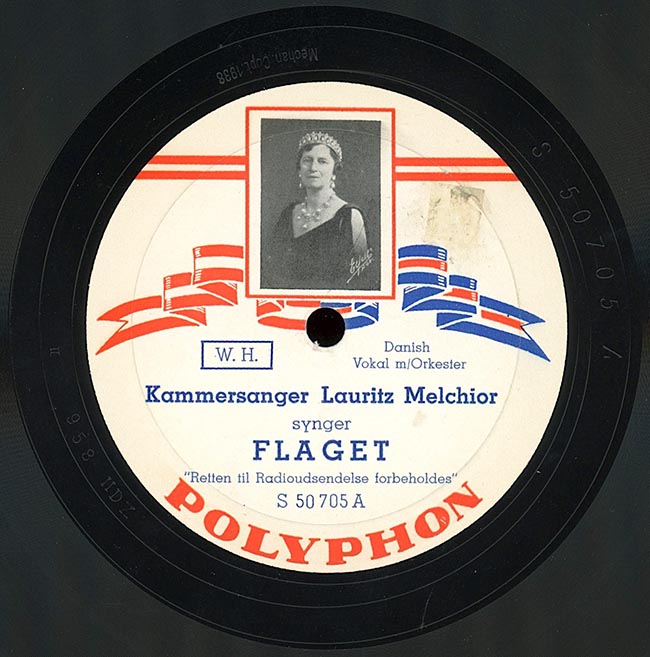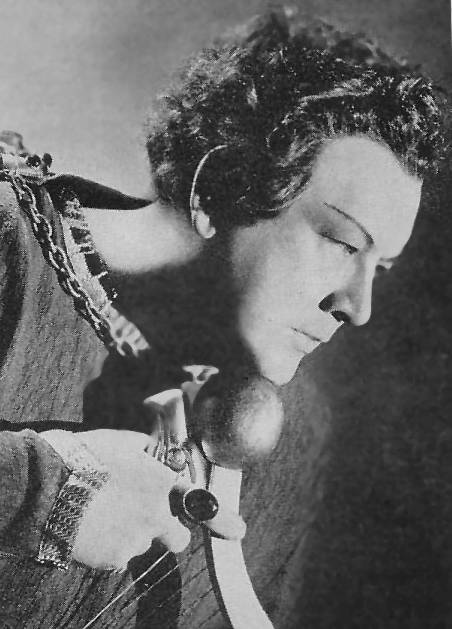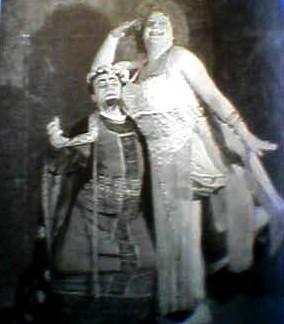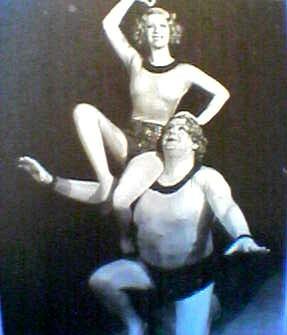Lauritz Melchior
I wish to thank Thomas Silverbörg for the picture.
I wish to thank Vladimir Efimenko for the pictures.

As a boy, Melchior sang in a church choir, first as a soprano, then as a bass. At age 18, he started taking voice lessons in Copenhagen,
as a baritone; he made his unofficial debuts in 1911 in a school production in Copenhagen as Antonio in Le nozze di Figaro, then
in 1912 as Germont with a small touring company, and his official debut the following year at the Royal Opera Copenhagen, as Silvio. For
the next few years, he sang in Copenhagen, mostly comprimario parts, but not exclusively: as Luna in 1916, in an attempt to help a
nervous Leonora, he interpolated a high C at the end of the Luna-Leonora duet. It was that performance's Azucena, Sarah Cahier, who told
him that he was actually a tenor, and advised him to restudy. He did so, with Vilhelm Herold.
In October 1918, he made his tenor debut as Tannhäuser, again at the Royal Opera Copenhagen. When that theater made some guest
performances in London in 1920, the novelist Hugh Walpole was so impressed with Melchior's voice that he offered to pay for his further
studies. So from 1922, Melchior trained for being a true heldentenor in London and Germany (with Victor Beigel, Ernst Grenzebach
and Anna Bahr-Mildenburg). He resumed his career in 1924, and soon caused a sensation as Siegmund at Covent Garden: the epitome of the
heldentenor was born, a baritonal voice of endless power and breath, but (unlike most other heldentenors) with an impressive high C.
The centers of his career were Covent Garden (1924–39), the Bayreuth Festival (1924–31), the New York Met (1926–50)
and the Berlin Staatsoper (1925–39); as a guest, he sang at the Vienna Staatsoper, the Paris Opéra, in Brussels, Antwerp,
Den Haag, Barcelona, Hamburg, Munich, Milano, Stockholm, Chicago, San Francisco or Buenos Aires. At the Met, he appeared on 519 evenings,
in just seven roles – Wagner only (apart from concerts): Siegmund, both Siegfrieds, Tristan, Parsifal, Lohengrin,
Tannhäuser.
After his 1950 Met farewell, Melchior continued to appear in concert, on radio and TV into the 1960s, with undiminished vocal power
– and at least occasionally also in opera, the last time in Copenhagen in 1960, as Lohengrin. Already in the 1940s, he had begun
to make use of his considerable comic talent as a (musical) film actor.
Reference 1: Youtube channel "Dead Tenors' Society"; reference 2: Kutsch & Riemens, reference 3
Le nozze di Figaro (Antonio) – Copenhagen, Casino Theater, 15 February 1911 La traviata (Germont) – tour through Denmark, September-October 1912 Pagliacci (Silvio) – Copenhagen, Royal Opera, 2 April 1913 La traviata (Douphol) – Copenhagen, Royal Opera, 20 May 1913 En søndag pa Amager by Heiberg (Per) – Copenhagen, Royal Opera, 6 September 1913 Carmen (Morales) – Copenhagen, Royal Opera, 12 October 1913 Liden Kirsten by Hartmann (Sverkel) – Copenhagen, Royal Opera, 26 October 1913 Le roi l'a dit (Merlussac) – Copenhagen, Royal Opera, 4 January 1914 Der Freischütz – Copenhagen, Royal Opera, 8 November 1914 Der Evangelimann (Anton) – Copenhagen, Royal Opera, 11 November 1914 Iolanta (Ibn Jahin) – Copenhagen, Royal Opera, 6 January 1915 La muette de Portici – Copenhagen, Royal Opera, 29 January 1915 Vølund Smed by Holger (Minstrel) – Copenhagen, Royal Opera, 6 February 1915 Drot ot Mask by Reise (Arved Bengtsen) – Copenhagen, Royal Opera, 14 February 1915 Parsifal (Ritter) – Copenhagen, Royal Opera, 9 April 1915 Tannhäuser (Heinrich der Schreiber) – Copenhagen, Royal Opera, 20 October 1915 Il trovatore (Luna) – tour through Sweden, April 1916 Faust (Brander) – Copenhagen, Royal Opera, 4 September 1916 Der Rosenkavalier (Faninal) – Copenhagen, Royal Opera, 4 November 1916 Gloria Arsena by Enna (Louvet) – Copenhagen, Royal Opera, 15 April 1917 Tannhäuser – Copenhagen, Royal Opera, 8 October 1918 Salome (Jew) – Copenhagen, Royal Opera, 26 April 1919 Pagliacci – Copenhagen, Royal Opera, 1 May 1919 Samson et Dalila – Copenhagen, Royal Opera, 20 April 1920 Cavalleria rusticana – Nuremberg, Stadttheater, 27 April 1924 Die Walküre – London, Covent Garden, 14 May 1924 Parsifal – Bayreuth, Festspielhaus, 23 July 1924 Siegfried – Magdeburg, Stadttheater, 25 November 1925 Götterdämmerung – Bayreuth, Festspielhaus, 26 July 1927 Lohengrin – Hamburg, Opernhaus, 31 October 1927 Aida – Hamburg, Opernhaus, 30 January 1928 Otello – Hamburg, Opernhaus, 31 May 1928 Le prophète – Hamburg, Opernhaus, 20 December 1928 Tristan und Isolde – Barcelona, Liceo, 1 February 1929 Fidelio – Buenos Aires, Colón, 18 August 1933 Many thanks to Anton Bieber for the rare Flaget recording, with label scan. I would like to thank Daniele Godor for the recording (Winterstürme wichen dem Wonnemond in Danish). I would like to thank Thomas Silverbörg for the recording (Wälse!). Reference: Eduardo Arnosi Lauritz Melchior, El coloso wagneriano, Buenos Aires, 1994 |


